Every department has its own rhythm. Marketing runs on campaigns, operations tracks inventory, HR manages onboarding sequences, and finance follows approval chains. The challenge isn’t that teams work differently. The challenge is that their work constantly intersects, and those handoffs are where momentum is often lost.
A workflow app connects these moving pieces into a single, visible system. Instead of chasing updates across email threads and spreadsheets, work flows automatically between teams. Requests route to the right people. Approvals happen without bottlenecks. And leadership gets a real-time view of progress across the entire organization.
This guide examines 15 workflow apps that actually bridge departmental gaps. You’ll see exactly what each costs, where they shine, and — most importantly — how to pick one your teams will genuinely use.
Try monday work managementWhat is a workflow app?
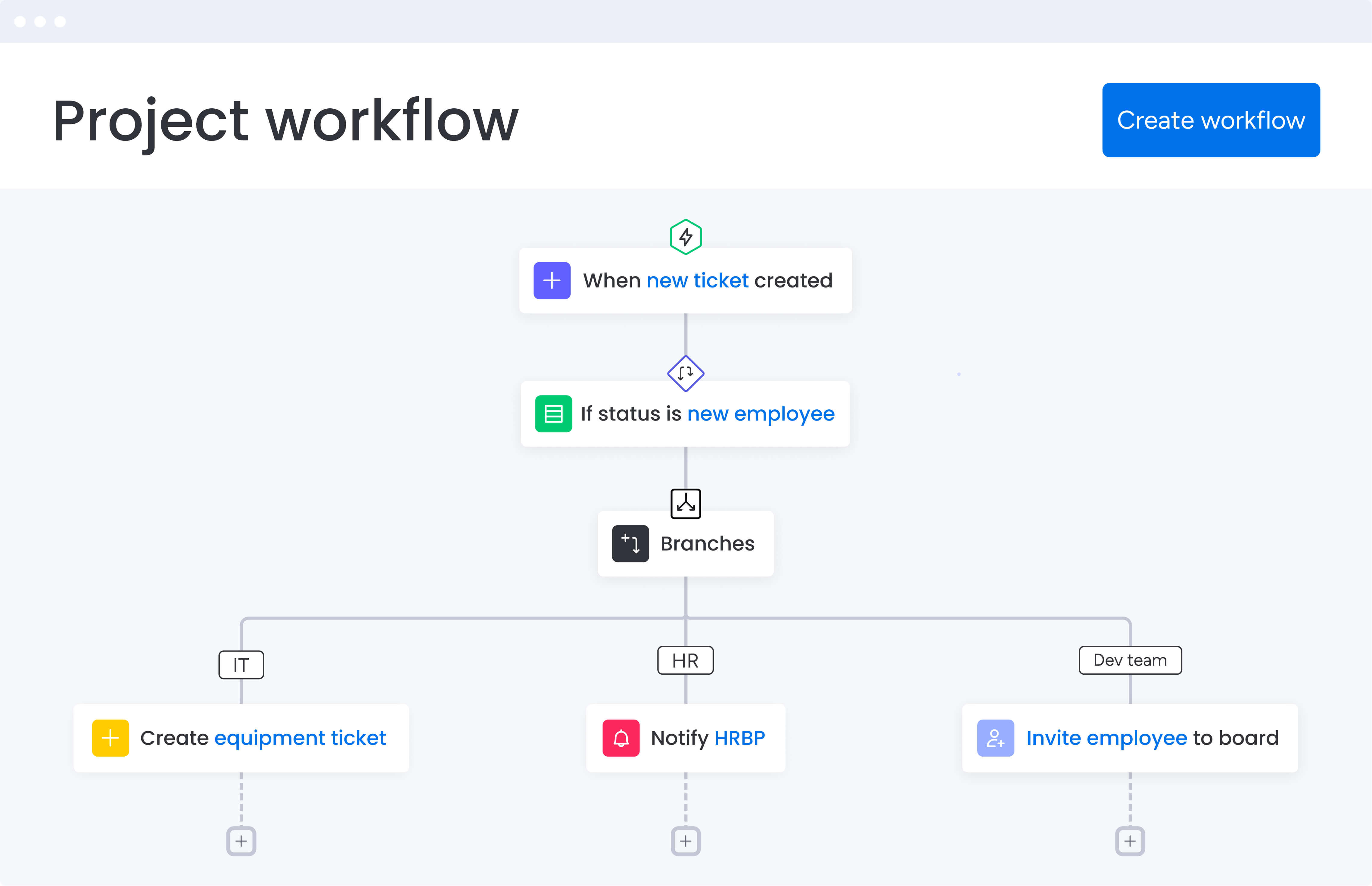
Think of a workflow app as the digital nervous system of your organization. It connects people, processes, and data into a cohesive unit, replacing fragmented handoffs with a unified platform. Instead of work getting lost in email threads or static spreadsheets, it flows automatically across departments.
While standard project management tools often focus on a single team’s tasks, a workflow app orchestrates complex operations from end to end. This architecture provides leadership with a macro view of progress while ensuring individual contributors understand their immediate priorities.
Put simply, these platforms transform complex bottlenecks into smooth handoffs. The right platform adds just enough structure to keep work flowing without drowning teams in process.
For example:
- Employee onboarding: HR, IT, and department heads are linked in an automated sequence, ensuring new hires are equipped immediately.
- Content approval: Creative assets glide through creation, legal review, and final sign-off, generating an automatic audit trail.
- Deal-to-delivery: Closing a sales deal instantly activates the operations team’s implementation protocol, guaranteeing a seamless client handover.
15 best workflow apps for cross-department collaboration
Finding a simple process tracker is easy. Finding software that actually connects your entire business? That’s harder. Each platform here earned its spot by proving it can break down silos, move work automatically between teams, and keep everyone working from the same facts.
Whether you need to coordinate simple tasks or build an entire business command center, you’ll find options that fit. These platforms help scattered teams work as one — no more wasted energy chasing updates or duplicating work.
| Platform | Use case | Free plan? | Notable feature | Starting price |
|---|---|---|---|---|
| monday work management | Organizations running complex, multi-departmental initiatives that need shared visibility without losing their preferred ways of working | Yes | Cross-team handoffs with clear ownership and triggers | $9/seat/month |
| Lindy | Companies prioritizing advanced AI for workflow optimization, specifically those comfortable with AI-driven decision-making and autonomous execution | Yes | AI agents with computer use capability | $10/month |
| ClickUp | Organizations looking to condense their tech stack into a single platform that manages everything from project planning to team communication | Yes | Unified workspace with 15+ visualization options | $7/user/month |
| Asana | Companies requiring clear visibility from strategic objectives down to task execution | Yes | Work Graph connectivity linking goals to tasks | $10.99/user/month |
| Trello | Small to mid-sized teams handling straightforward processes with few cross-functional dependencies | Yes | Visual Kanban boards with Butler automation | $5/user/month |
| Wrike | Large enterprises with dedicated PMOs that need sophisticated resource allocation and strict security controls | Yes | Advanced resource management with capacity planning | $10/month |
| Smartsheet | Organizations heavily reliant on spreadsheets that want enterprise-grade automation without losing the grid interface | No | Control Center for standardized portfolio management | $9/user/month |
| Airtable | Teams that need to manage large volumes of structured information and require custom database structures | Yes | Relational database with two-way sync | $20/user/month |
| Jira | Organizations with technical teams needing sophisticated agile tools that also offer visibility to business stakeholders | Yes | Unified platform for software and business projects | $7.16/user/month |
| Notion | Teams that value documentation and knowledge sharing as much as workflow execution | Yes | Connected workspace for docs, wikis, and projects | $10/user/month |
| Basecamp | Small to mid-size teams that need streamlined coordination without the overhead of complex automation | Yes | Hill Charts for visual progress tracking | $15/user/month |
| Hive | Distributed teams needing flexible collaboration tools and diverse work views to support various locations and time zones | Yes | Integrated communication via native chat and Hive Mail | $5/user/month |
| Kissflow | Organizations aiming to standardize structured business processes with defined approval chains | No | AI-powered boards with auto-generated structures | $2,500/month |
| Nintex | Large enterprises needing advanced automation with complex logic and government-grade security | No | AI-powered generation of workflows and forms | $15,000/year |
| Zoho Projects | Small businesses and budget-conscious teams needing robust management tools with minimal upfront investment | Yes | Blueprint workflow automation for standardizing processes | Contact for pricing |
1. monday work management
Functioning as a centralized operating system, monday work management is where teams plan, execute, and report in unison. It is designed for organizations managing concurrent workstreams, allowing marketing, operations, HR, and PMO to maintain shared visibility without sacrificing their preferred workflows.
The primary friction point in cross-departmental work is the handoff. Determining ownership, timing, and tracking progress often involves chasing updates — a problem monday solves by centralizing the data.

Use case: Organizations running complex, multi-departmental initiatives that need shared visibility without losing their preferred ways of working
Key features
- Cross-team handoffs: Move work cleanly between teams with clear ownership, statuses, and triggers
- Workflow views: Visualize work flow in Kanban, Timeline, Gantt, or Calendar without breaking the process
- Automation-first execution: Trigger actions, approvals, and updates automatically as work progresses
Pricing
- Free: $0/month for 2 seats
- Basic: $9/seat/month (billed annually)
- Standard: $12/seat/month (billed annually)
- Pro: $19/seat/month (billed annually)
- Enterprise: Custom pricing (quote-based)
Why monday work management stands out
- Adapts to how teams work: Teams shape workflows without changing tools or processes, and it’s built to manage handoffs, not just tasks or projects.
- Scales from simple to complex flows: Works for lightweight requests and multi-step cross-team workflows.
2. Lindy
By deploying AI agents as digital employees, Lindy fundamentally shifts the approach to automation. These agents execute tangible work across emails, phone calls, and software interfaces. The platform emphasizes no-code agent creation with advanced abilities like computer use and voice interaction, catering to organizations ready to adopt autonomous AI execution. Teams can construct intelligent workflows that evolve with user behavior, moving beyond basic tasks to comprehensive orchestration.
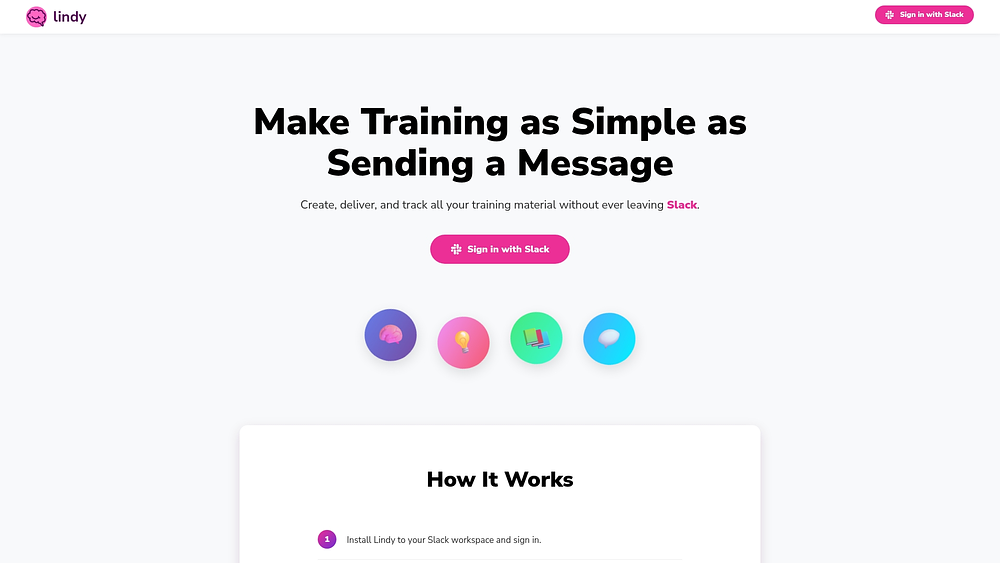
Use case: Companies prioritizing advanced AI for workflow optimization, specifically those comfortable with AI-driven decision-making and autonomous execution within their operations
Key features
- No-code agent builder: Generate AI agents via prompts or templates to manage email, calls, and GUI automation across thousands of apps
- Computer use capability: Agents function within virtual browsers with persistent sessions, automating web-based tasks that lack API access
- Native phone agents: Manage inbound and outbound calls in over 30 languages, featuring human transfer options and post-call triggers
Pricing
- Free tier: 400 credits and core features for exploration.
- Phone add-on: $10/month per number plus per-minute rates.
- Vertical plans: Medical scribe options start at $199/month (20,000 credits).
- Enterprise: Custom pricing for large-scale deployments with enhanced governance.
Considerations
- The credit-based model can be unpredictable for new users, as advanced features consume credits rapidly.
- Designing multi-step agentic workflows requires precise prompting and iteration to ensure reliability in complex processes.
3. ClickUp
ClickUp aims to replace fragmented toolsets by housing tasks, docs, and goals under one roof. It consolidates multiple work functions into a comprehensive workspace, offering extensive customization and view types. For teams seeking feature breadth and willing to invest time in configuration, ClickUp provides a centralized alternative to using multiple disparate platforms.
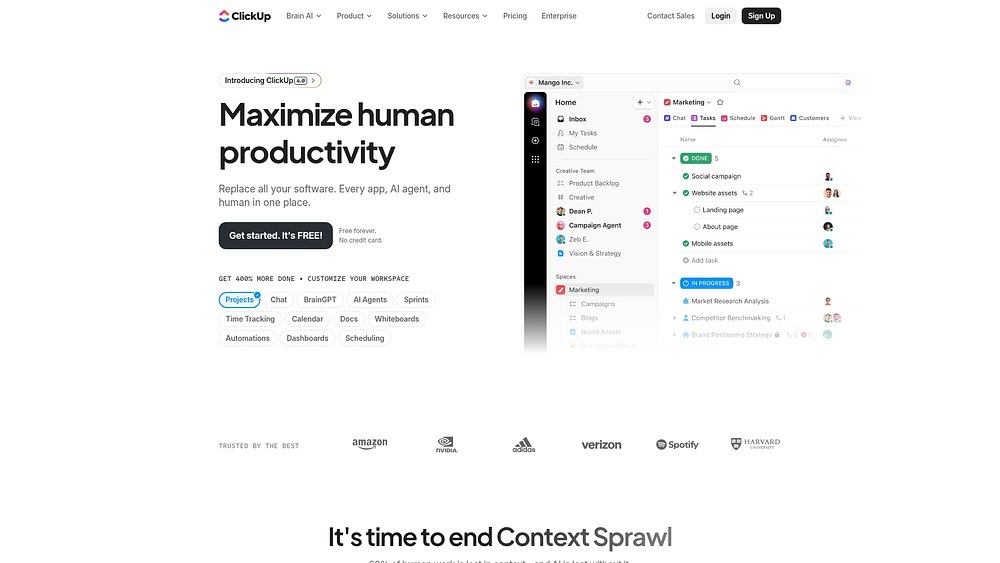
Use case: Organizations looking to condense their tech stack into a single platform that manages everything from project planning to team communication and knowledge management
Key features
- Unified workspace: Integrating tasks, docs, whiteboards, chat, forms, and dashboards
- ClickUp Brain AI integration: Featuring agents, connected search, and AI-powered automation
- Extensive customization: With over 15 visualization options, including Gantt, Kanban, and Workload management
Pricing
- Free Forever: Basic features with 60MB storage.
- Unlimited: $7/month per user (annual) with unlimited storage and integrations.
- Business: $12/month per user (annual) adding Google SSO and workload management.
- Enterprise: Custom pricing with white labeling and HIPAA compliance.
- AI add-ons available separately.
Considerations
- The sheer volume of features can create a steep learning curve, complicating cross-departmental adoption.
- Users have reported performance lags in large workspaces or when utilizing data-heavy views.
4. Asana
The core of Asana’s value lies in its Work Graph data model, which connects every individual task back to a broader strategic goal. It excels at aligning strategy with execution, making it a strong choice for organizations that need to link departmental OKRs to daily activities. While its strength is departmental coordination, its robust feature set offers enterprise-grade clarity for teams of all sizes.
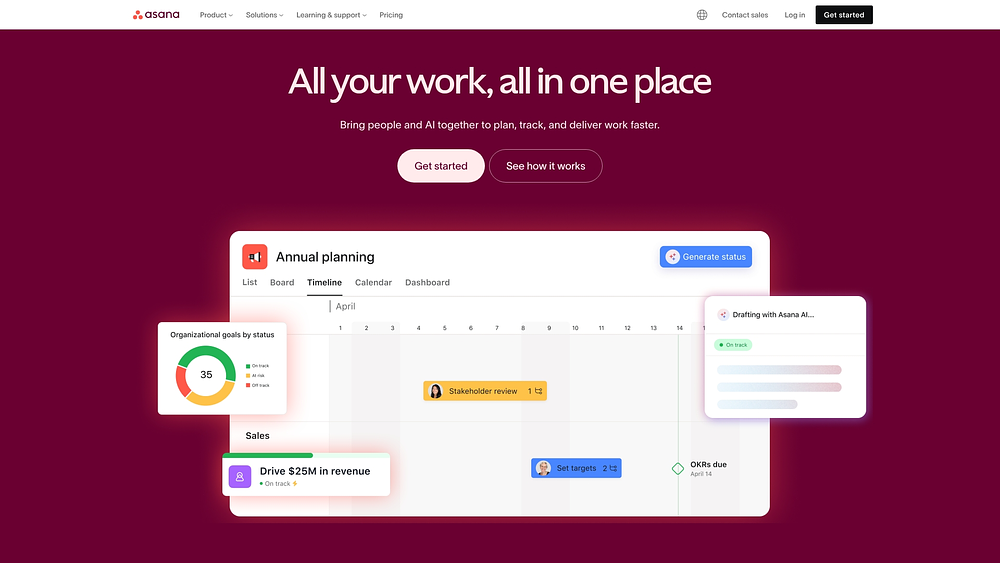
Use case: Companies requiring clear visibility from strategic objectives down to task execution, specifically those needing to bridge departmental work with company-wide goals
Key features
- Work Graph connectivity: Unifies goals, portfolios, projects, and tasks in a single data model
- AI Studio and Smart Workflows: No-code AI workflow design with prebuilt templates and emerging AI Teammates
- Multi-project coordination: Tasks can exist in multiple projects simultaneously (multi-homing), reducing duplication
Pricing
- Personal: Free for up to 2 users.
- Starter: $10.99/month per user (annual).
- Advanced: $24.99/month per user (annual) with Goals and Portfolios.
- Enterprise & Enterprise+: Custom pricing with advanced security.
- AI Studio Plus: $135/month per account.
Considerations
- The single-assignee model can be restrictive for teams that prefer shared task ownership.
- Accessing strategic features like Goals and Portfolios requires higher-tier plans, which may impact budget for smaller teams.
5. Trello
Trello strips away complexity, offering a purely visual approach to project tracking through boards, lists, and cards. It specializes in Kanban-based workflows supported by automation, ideal for teams that value immediate clarity over intricate feature sets. With a massive global user base, Trello demonstrates that effective management doesn’t always require a steep learning curve.
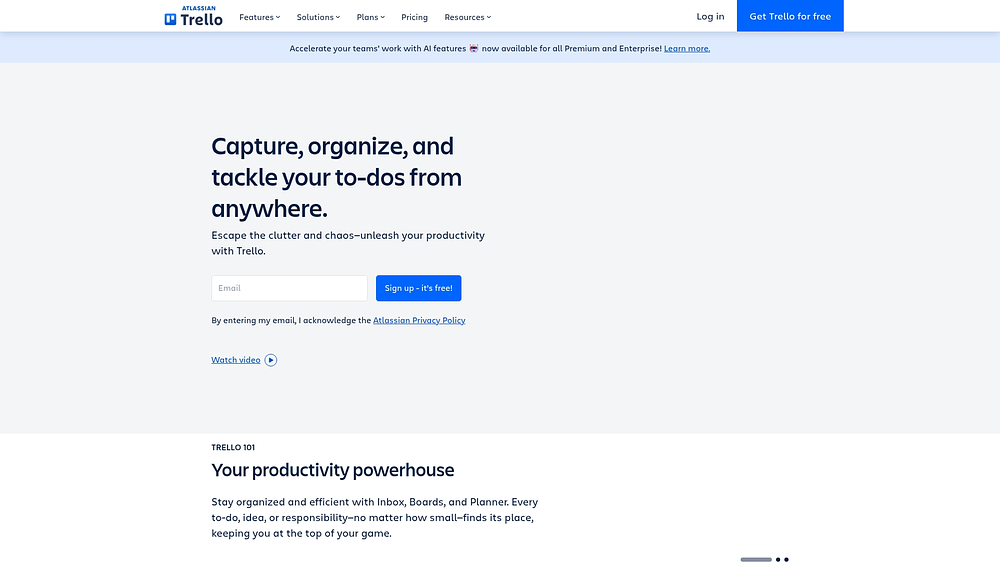
Use case: Small to mid-sized teams handling straightforward processes with few cross-functional dependencies who prioritize quick adoption
Key features
- Visual Kanban boards: Intuitive lists and cards that make work instantly visible
- Butler automation: No-code rules and scheduled commands that eliminate repetitive work
- Multiple view options: Timeline, Calendar, and Dashboard views for different perspectives
Pricing
- Free: $0/month with up to 10 collaborators.
- Standard: $5/user/month (annual).
- Premium: $10/user/month (annual) with AI features and unlimited automation.
- Enterprise: $17.50/user/month (annual) with advanced security.
Considerations
- Native reporting and portfolio management are limited for complex, multi-departmental workflows.
- Advanced features often necessitate third-party Power-Ups, which can increase costs.
6. Wrike
For large-scale enterprises needing rigorous security and resource planning, Wrike offers a robust solution. It covers the entire work lifecycle, from ideation to analysis, making it suitable for organizations with complex allocation requirements. Features like customer-managed encryption keys and locked spaces distinguish it in regulated sectors.
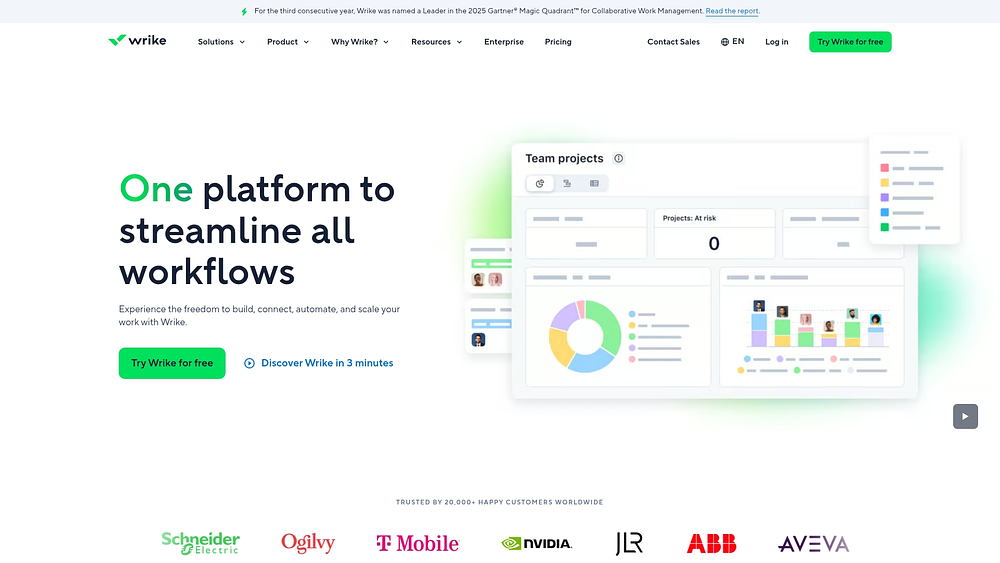
Use case: Large enterprises with dedicated PMOs that need sophisticated resource allocation, portfolio management, and strict security controls
Key features
- Advanced resource management: Capacity planning, budgeting, and utilization dashboards
- AI-powered automation: Work Intelligence features including Copilot and AI Agents
- Enterprise security: Wrike Lock (customer-managed keys) and SOC 2 Type II compliance
Pricing
- Free: $0/month with basic views.
- Team: $10/month (annual) for 2-15 users.
- Business: $25/month (annual) for 5-200 users.
- Enterprise: Contact sales for advanced security.
- Pinnacle: Contact sales for comprehensive resource management.
Considerations
- The high level of configurability creates a learning curve that often requires Professional Services for larger teams.
- Key enterprise capabilities like Wrike Lock and premium support are paid add-ons.
7. Smartsheet
Smartsheet bridges the gap between simple grids and complex project management, turning familiar spreadsheet interfaces into powerful workflow platforms. It combines Excel-like views with advanced automation and governance, appealing to teams comfortable with spreadsheet-based processes. Its widespread adoption among Fortune 500 companies underscores its utility for large-scale management.
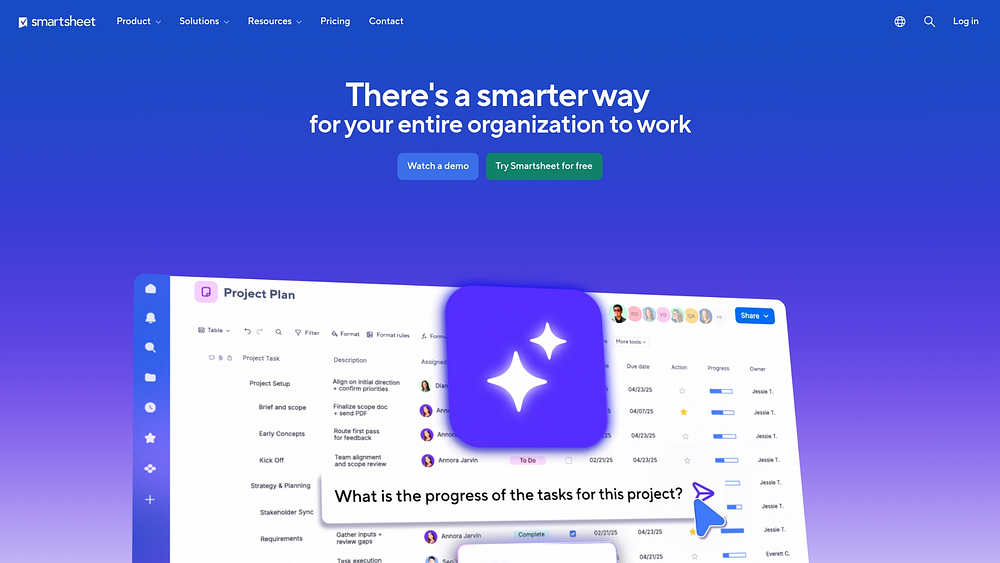
Use case: Organizations heavily reliant on spreadsheets that want to introduce enterprise-grade automation and governance without losing the grid interface
Key features
- Multi-view execution: Grid, Gantt, Kanban, and Calendar views let teams work their way
- Control Center: Standardized portfolio management with automated provisioning at scale
- Dynamic View: Granular data sharing based on roles without exposing sensitive information
Pricing
- Pro: $9/month per user (annual).
- Business: $19/month per user (annual).
- Enterprise: Custom pricing.
- Advanced Work Management: Custom pricing for premium apps.
Considerations
- Scale limitations (20,000 rows) may constrain very large datasets.
- Premium features like Control Center often incur additional costs.
8. Airtable
Airtable gives teams the power of a relational database wrapped in a user-friendly interface. It merges spreadsheet familiarity with database functionality, allowing for structured data management without technical hurdles. Used by a vast number of organizations, it is a proven tool for managing complex data relationships.
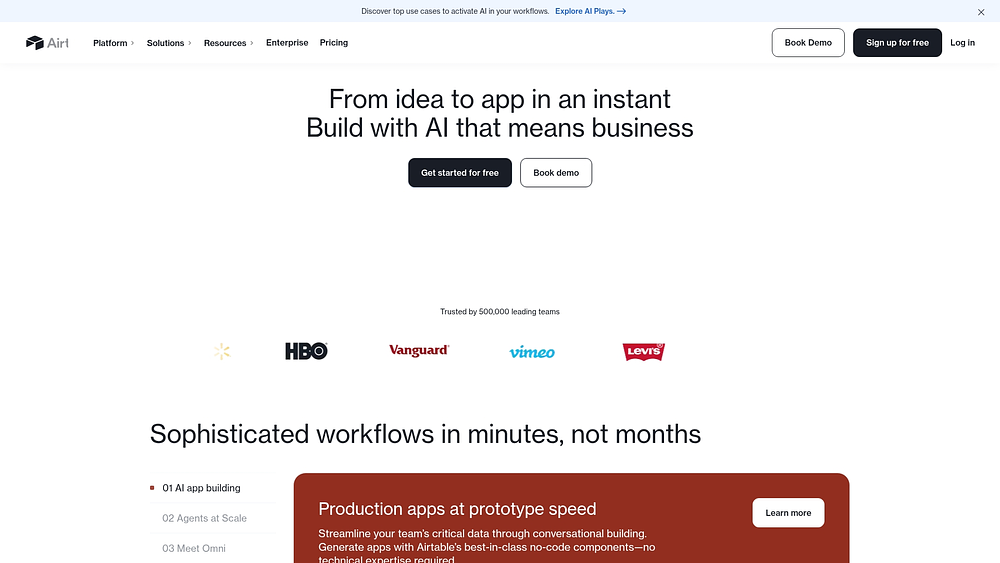
Use case: Teams that need to manage large volumes of structured information and require custom database structures within their workflows
Key features
- Relational database foundation: Connect records across bases with two-way sync
- AI-native automation: Use Omni AI app builder and agents to automate operations
- Enterprise-scale architecture: HyperDB supports up to 100 million records per table
Pricing
- Free: 1,000 records per base.
- Team: $20/month per collaborator (annual).
- Business: $45/month per collaborator (annual).
- Enterprise Scale: Custom pricing.
Considerations
- Advanced integrations often require higher-tier plans.
- Two-way sync has specific limitations regarding cell counts and attachment types.
9. Jira
Synonymous with agile development, Jira bridges the gap between engineering tickets and broader business objectives. It unifies software development with business workflows, breaking down silos between technical and non-technical teams. It is the standard for organizations where engineering needs to collaborate closely with marketing, sales, and operations.
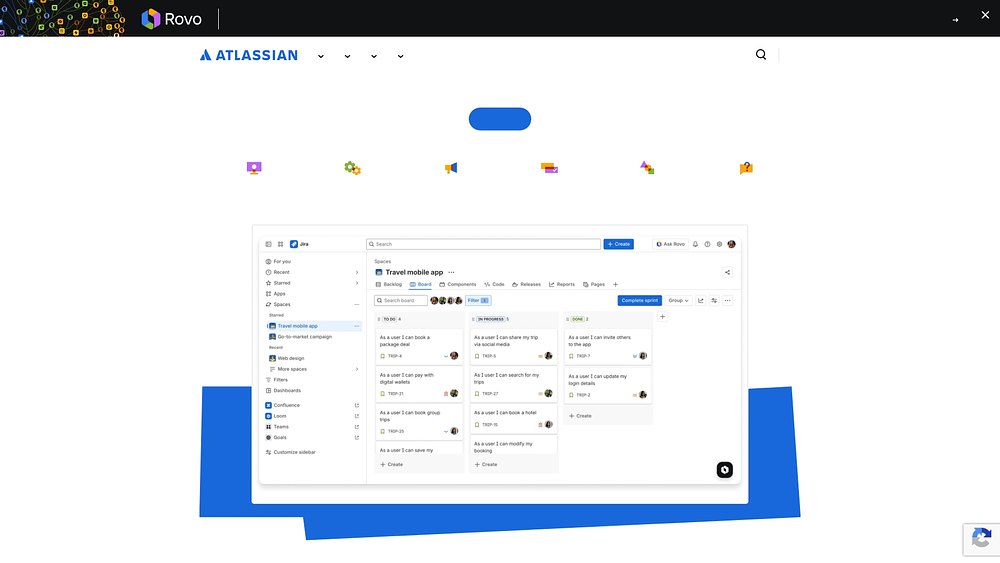
Use case: Organizations with technical teams needing sophisticated agile tools that also offer visibility to business stakeholders
Key features
- Unified platform: Supports both software (Scrum/sprint) and business projects in one system
- Rovo AI agents: Automate work breakdown and provide intelligent assistance
- Massive marketplace: Access over 5,700 apps for extended functionality
Pricing
- Free: Up to 10 users.
- Standard: $7.16/user/month (annual).
- Premium: $12.48/user/month (annual).
- Enterprise: Custom pricing.
Considerations
- Setup complexity can be high, particularly for custom workflows.
- Business projects may lack the full Scrum capabilities found in software projects.
10. Notion
Notion blurs the lines between document creation and project management. It unifies documentation, databases, and tracking in a flexible workspace, excelling at knowledge management. For organizations that prioritize thorough process documentation alongside execution, Notion reduces context switching by integrating these functions.
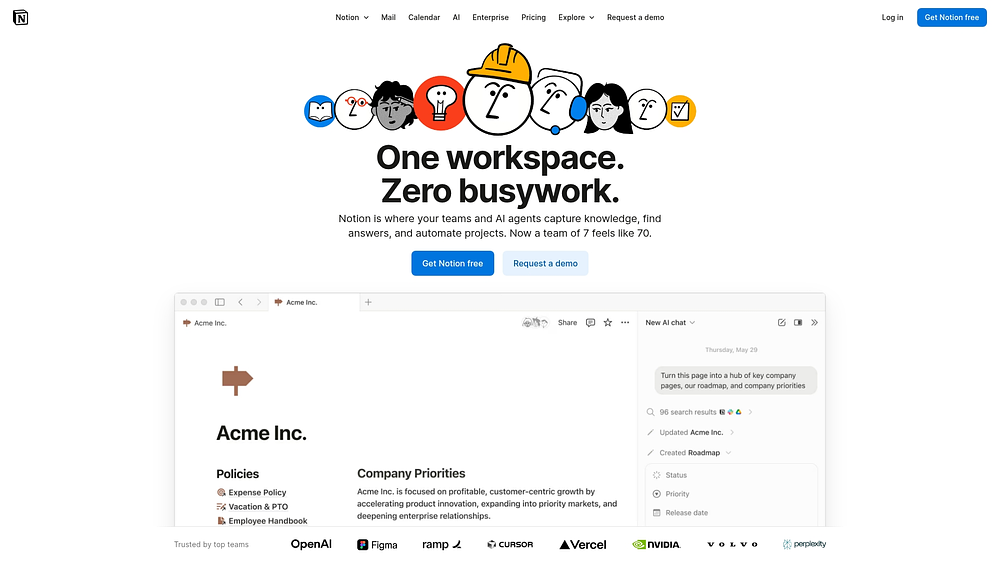
Use case: Teams that value documentation and knowledge sharing as much as workflow execution, such as those building internal wikis
Key features
- Connected workspace: Unifies docs, wikis, and project databases in one interface with AI-powered search that surfaces relevant information across all content types
- Integrated time management: Native Notion Calendar syncs with project timelines and task databases, keeping schedules aligned with execution
- Flexible database system: Customizable databases with table, board, timeline, calendar, gallery, and list views that adapt to different team preferences
Pricing
- Free: $0 per member/month.
- Plus: $10 per member/month.
- Business: $20 per member/month.
- Enterprise: Custom pricing.
Considerations
- Calendar integration is currently limited to Google and Apple.
- Offline functionality is restricted, requiring manual downloads.
11. Basecamp
Basecamp prioritizes clarity and communication over complex feature sets. It organizes work around conversational threads and message boards rather than intricate workflows. This straightforward approach is attractive to teams that want to avoid the noise of enterprise-level automation.
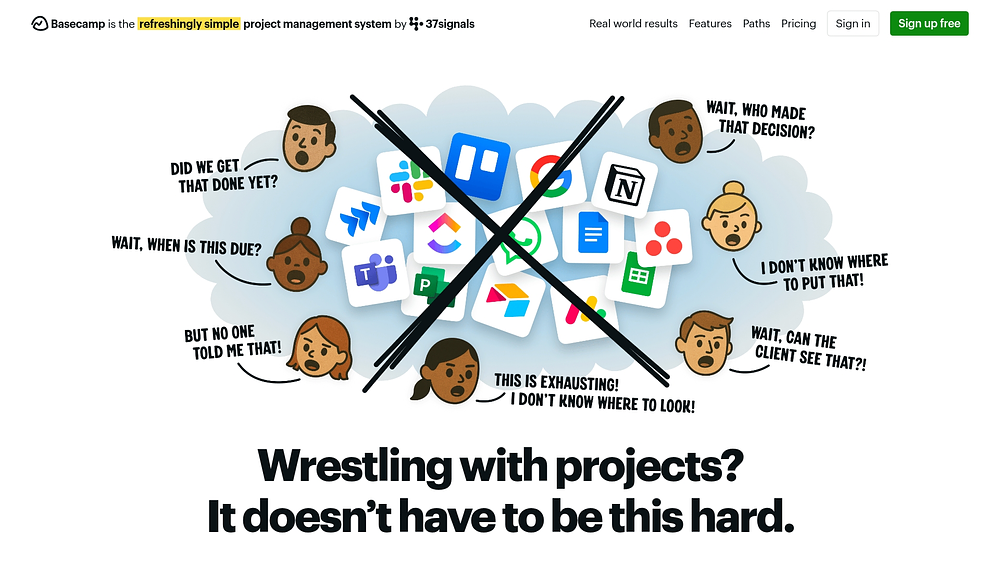
Use case: Small to mid-size teams that need streamlined coordination without the overhead of complex automation
Key features
- Message boards and threaded discussions: Organize conversations by topic rather than inbox chaos, keeping context intact and decisions visible to everyone who needs them
- Hill Charts for visual progress tracking: See where work actually stands with intuitive visual indicators that show whether tasks are climbing toward completion or coasting downhill to done
- Client collaboration features with guest access: Bring external partners into specific projects without exposing your entire workspace, maintaining control while fostering transparent collaboration
Pricing
- Free: $0/month for limited use.
- Plus: $15/user/month.
- Pro Unlimited: $299/month (annual).
Considerations
- Lacks advanced features like complex dependencies and analytics.
- English-only interface with U.S. data centers.
12. Hive
Built with hybrid teams in mind, Hive integrates native messaging directly into the project workflow. It combines project management with chat, email, and AI assistance to keep distributed teams connected. Users benefit from multiple project views and real-time collaboration tools within a single environment.
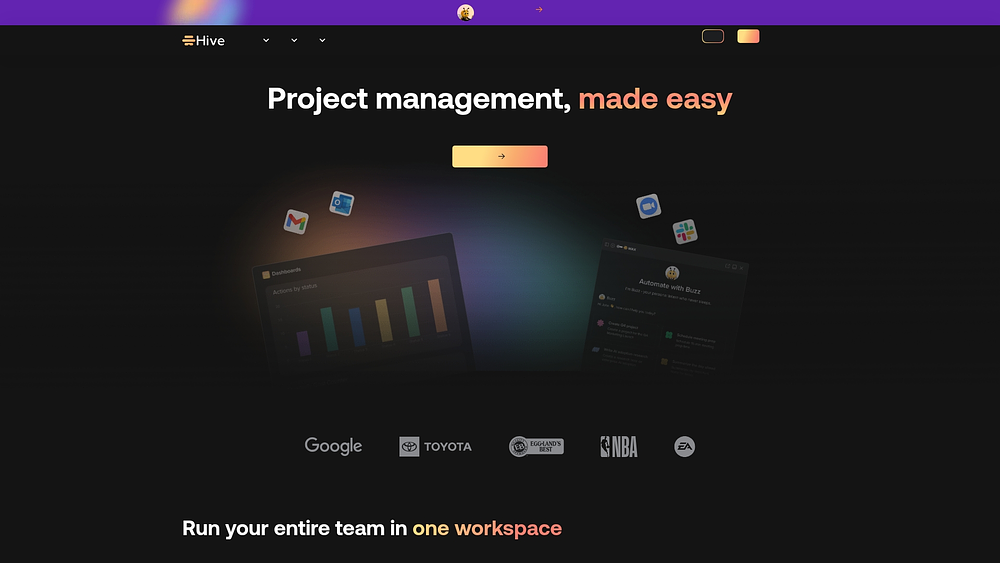
Use case: Distributed teams needing flexible collaboration tools and diverse work views to support various locations and time zones
Key features
- Multiple project views: Switch between visualization styles without losing context
- Integrated communication via native chat and Hive Mail: Keep conversations connected to the work itself with built-in messaging
- Buzz AI assistant for task creation and analytics: Accelerate work with AI that helps generate tasks from natural language, surfaces insights, and answers questions
Pricing
- Free: $0 for up to 10 members.
- Starter: $5/user/month (annual).
- Teams: $12/user/month (annual).
- Enterprise: Custom pricing.
Considerations
- Add-on pricing can increase costs for features like proofing and timesheets.
- Some users find the UI complex due to frequent updates.
13. Kissflow
Kissflow targets the specific needs of business process management (BPM) through low-code flexibility. It replaces scattered spreadsheets with unified automation and AI-powered boards. The platform is particularly suited for mid-market and enterprise organizations looking to digitize approval chains while maintaining strict governance.
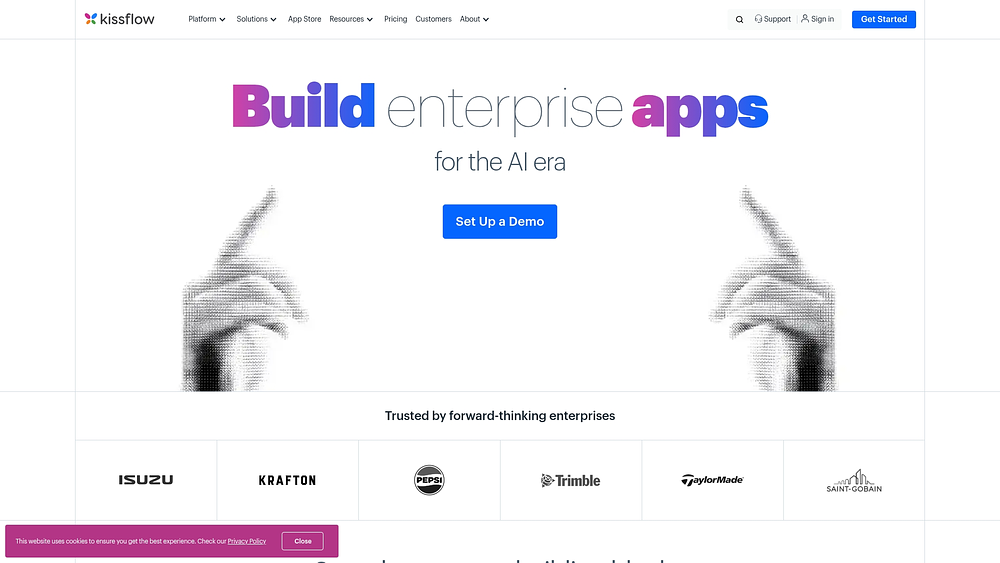
Use case: Organizations aiming to standardize structured business processes with defined approval chains
Key features
- AI-powered boards with auto-generated structures: Let AI build your workflow foundation, then refine it to match your exact process needs
- Drag-and-drop builders for process automation: Design complex approval chains and routing logic without writing a single line of code
- Secure external portals for partner collaboration: Bring vendors and partners into controlled spaces where they can submit requests and track progress without accessing internal systems
Pricing
- Basic: Starts at $2,500/month.
- Enterprise: Custom pricing.
Considerations
- The starting price point may be prohibitive for smaller teams.
- Some limitations exist regarding advanced reporting and customization depth.
14. Nintex
Nintex handles the heavy lifting for intricate, multi-step automations that require strict governance. It combines AI-powered workflow generation with enterprise-grade security, making it a strong contender for large organizations with compliance needs. It positions itself as an orchestration platform that unifies process intelligence with execution.
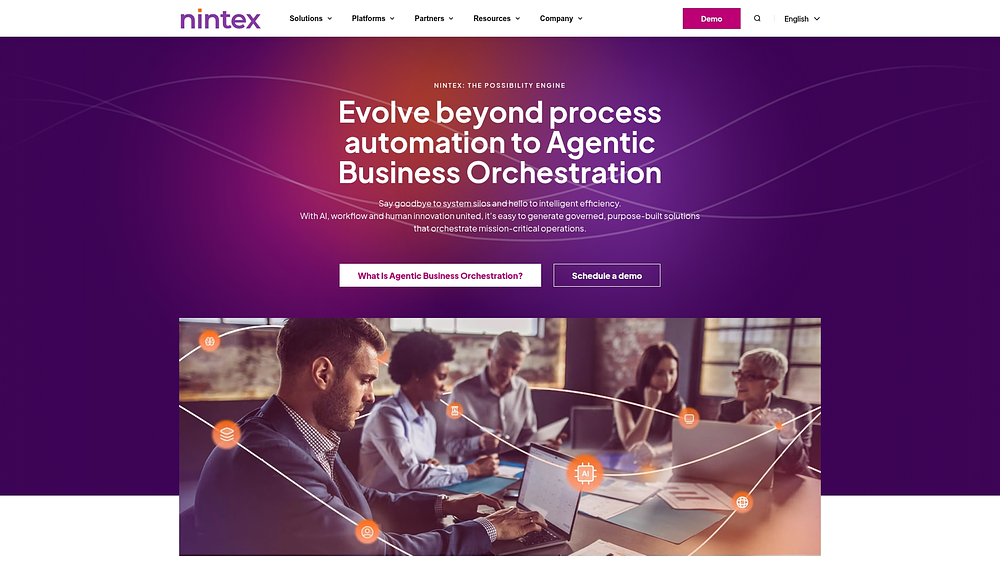
Use case: Large enterprises needing advanced automation with complex logic and government-grade security
Key features
- AI-powered generation of workflows and forms: Describe your process in plain language and let AI build the workflow structure, then refine the logic
- Unified task management via My Nintex dashboard: Consolidate all assigned work across processes into a single view
- Hybrid deployment options (cloud and on-premises): Choose where your workflows run based on security requirements, regulatory constraints, or infrastructure preferences
Pricing
- Automation Cloud Essentials: Starts at $15,000/year.
- Pro and Expert: Quote-based.
Considerations
- Deprecated legacy actions may require refactoring.
- Limits on draft forms can constrain long-running workflows.
15. Zoho Projects – Best budget-friendly option
As part of the broader Zoho ecosystem, Projects offers a cost-effective route to enterprise-style planning. It delivers robust capabilities at an accessible price point, integrating seamlessly with other Zoho tools. Teams gain access to time tracking, budgeting, and automation without the premium price tag.
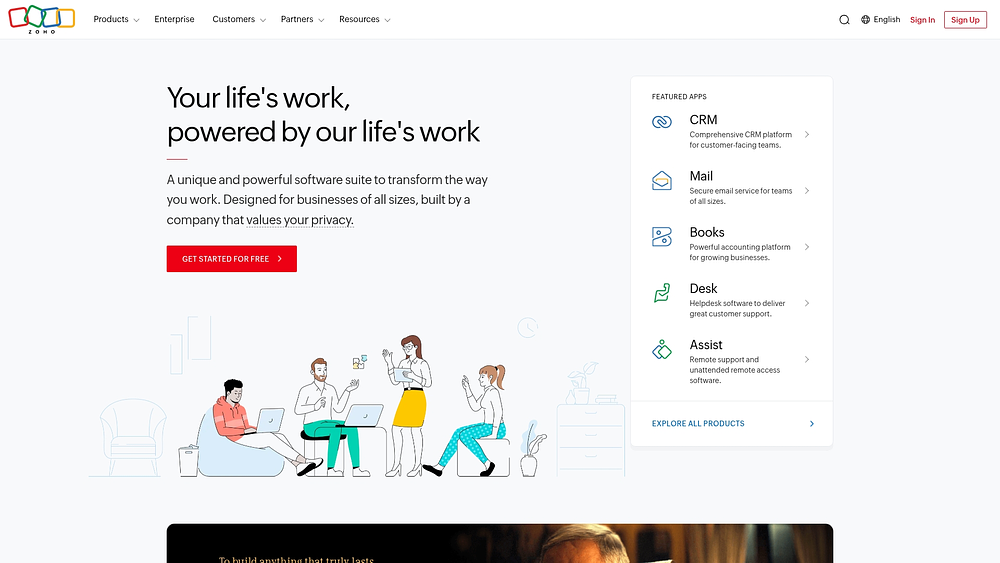
Use case: Small businesses and budget-conscious teams needing robust management tools with minimal upfront investment
Key features
- Gantt charts with critical path analysis: Visualize dependencies and identify bottlenecks that could delay your entire project timeline
- Blueprint workflow automation for standardizing processes: Lock in repeatable workflows that ensure consistency across teams without manual oversight
- Native integration with Zoho CRM, Books, and Analytics: Connect project execution directly to customer data, financial tracking, and business intelligence
Pricing
- Free: Up to 5 users.
- Premium/Enterprise/Ultimate: Contact for pricing.
Considerations
- The interface can be complex for advanced configuration.
- Resource utilization views may require careful process design.
Key features every workflow app should have
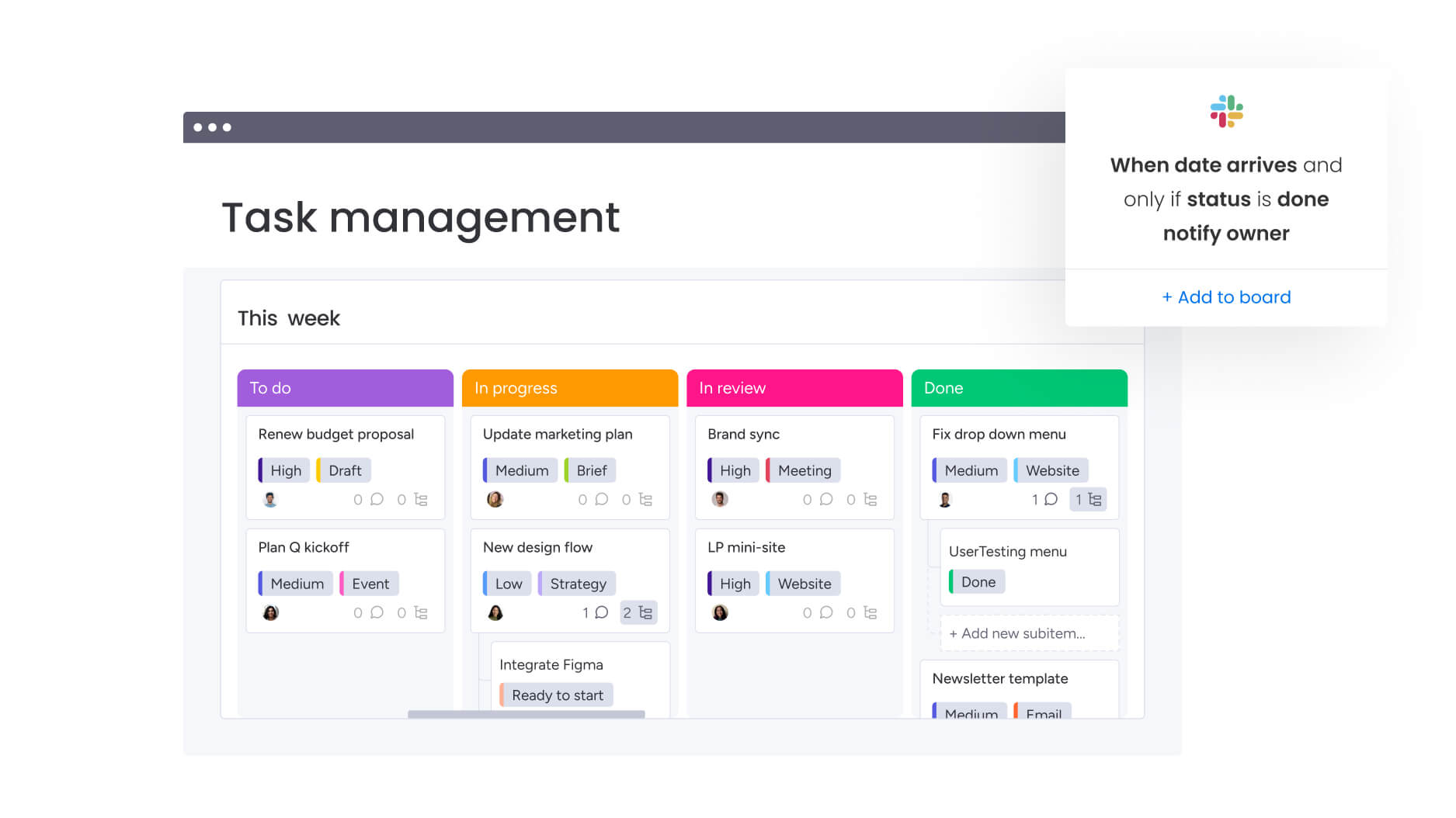
Momentum dies in silos. To truly unify an organization, a platform needs to do more than track tasks; it must actively bridge the gaps between teams.
Effective platforms empower users to construct, automate, and link their work. Prioritize these core capabilities to ensure your workflows foster alignment rather than fragmentation.
- Customizable workflows: The software should mold to your team’s reality, not force a rigid structure. Seek out flexible, no-code builders that allow departments to tailor processes while remaining aligned with broader company objectives through effective workflow management.
- Automations: Manual handoffs are the enemy of speed. Superior platforms utilize robust automation recipes to route work based on logic, connecting processes across departments and keeping momentum alive.
- Built-in collaboration: Context is king. A platform must link conversations, files, and decisions directly to the relevant tasks, sparing teams from the archaeological dig of email threads.
- Cross-departmental reporting: Leaders require a panoramic view of performance. Customizable dashboards that aggregate real-time data from various teams convert raw metrics into strategic insights.
- Robust integrations: Your workflow platform is the digital workspace, not an island. Strong API capabilities and native integrations are essential for creating a unified digital ecosystem that eliminates data silos.
- Enterprise-grade security and access: Balancing transparency with control is critical for complex organizations. Granular permissions and a secure mobile experience ensure that distributed teams remain connected without compromising data integrity.
These features form the bedrock of a genuine business operating system. With this power, you graduate from managing projects to orchestrating business-wide execution.
Try monday work managementHow to choose the right workflow app for cross-department success
Selecting software isn’t just a purchase; it’s an operational strategy. The objective is to identify a platform that acts as a bridge between departments, converting fragmented processes into a unified growth engine.
To pinpoint the solution that fits your organization, center your evaluation on three pillars. This method helps you look past feature lists to find a tool that delivers sustained value.
- Map your current challenges: Begin by diagnosing exactly where friction occurs. Where do handoffs stall? Where does data vanish? A platform’s worth is defined by its ability to solve these specific pain points.
- Prioritize organization-wide adoption: The most powerful platform is the one your teams actually use. Seek out intuitive interfaces that lower the barrier to entry. High engagement, like that seen with work management software, is the key to unlocking value across departments.
- Demand powerful integrations: Your departments depend on specialized tools, and a new platform shouldn’t create islands. A robust integration ecosystem links your tech stack, establishing a single source of truth and allowing teams to collaborate without abandoning their preferred apps.
Ultimately, the right choice balances immediate utility with future scalability. Choose a platform that not only addresses today’s issues but evolves with your organization, turning workflows into a lasting competitive edge.
AI and automation capabilities transforming workflow apps
AI is changing how work moves, not just how it’s tracked. Instead of endless status meetings and putting out fires, teams are using AI to spot issues before they happen and keep work flowing without constant prodding.
Moving from managing projects to orchestrating them requires a shift in tools. For organizations ready to level up, AI and automation unlock maturity in several ways.
- Anticipate outcomes: AI analyzes historical data to predict timelines and highlight risks, allowing leaders to intervene before problems escalate.
- Assign work intelligently: Tasks are routed automatically based on skill, capacity, and priority, eliminating resource bottlenecks.
- Accelerate approvals: Routine approval chains function autonomously, escalating only exceptions to human decision-makers.
Speed is just the start. The real win? Your workflows get smarter over time. Teams using smart work management software are embedding AI directly into their processes, so what was once a headache becomes a competitive edge.
Try monday work managementSecurity and compliance features for enterprise workflow apps

When you’re moving sensitive HR, finance, and legal data between teams, security isn’t optional — it’s critical. A data breach isn’t just an IT problem; it’s an existential threat. The best platforms bake security into their DNA so your teams can work freely without keeping executives up at night.
What defines enterprise-grade security in a work management context? It boils down to a few core capabilities that safeguard information and foster operational trust.
- Data encryption: This is the baseline. Information must be protected by top-tier encryption both at rest and in transit, rendering it unreadable to unauthorized eyes.
- Granular permissions: Control is paramount. Role-based access offers scalable templates, while custom permissions allow for unique workflow needs, ensuring collaboration doesn’t lead to overexposure.
- Complete audit trails: Accountability requires a clear, immutable record of every action. This is essential for compliance and incident investigation.
- Compliance certifications: Independent audits like SOC 2 Type II and ISO 27001 serve as verification that a platform meets rigorous global standards.
- Data residency options: In a global economy, location matters. Leading platforms offer choices for data storage to comply with regional regulations.
- Single sign-on (SSO) integration: Streamline access while hardening security. Integration with identity providers centralizes user management and enforces policies like MFA.
Building cross-departmental workflows demands a foundation of trust. Organizations running on software like monday work management benefit from multi-level permissions, comprehensive audit trails, and SOC 2 Type II compliance, allowing them to scale collaboration without scaling risk.

5 implementation strategies for successful cross-department adoption
Choosing the right technology is the first step. Inspiring your teams to embrace it is what ensures a successful rollout. Success happens when your team thinks, ‘This makes my day better,’ not when they’re forced to adopt yet another system.
To turn skeptical eye-rolls into genuine buy-in, you need to focus on people, not process. Here are five battle-tested strategies that create momentum instead of resistance.
Step 1: Start with a strategic pilot program
Limit risk and create a blueprint for success with a pilot. Select a team that is open to change and has workflows complex enough to demonstrate real impact. This generates a case study that can inspire other departments.
Step 2: Empower departmental champions
Identify natural leaders and tech enthusiasts to serve as champions. Equip them with advanced training so they can support their colleagues. Peer-to-peer support builds trust faster than a central helpdesk ever could.
Step 3: Balance standardization with customization
Standardize the “what” but allow flexibility in the “how.” Define core cross-departmental processes like intake or reporting to ensure consistency, but give teams the freedom to customize their internal workflows. This balance prevents chaos while empowering autonomy.
Step 4: Establish clear governance from day one
Governance provides the guardrails for growth. Define who can create workspaces and manage permissions early on. Setting these rules creates a secure, scalable environment and prevents the platform from becoming a digital wild west.
Step 5: Measure and share early wins
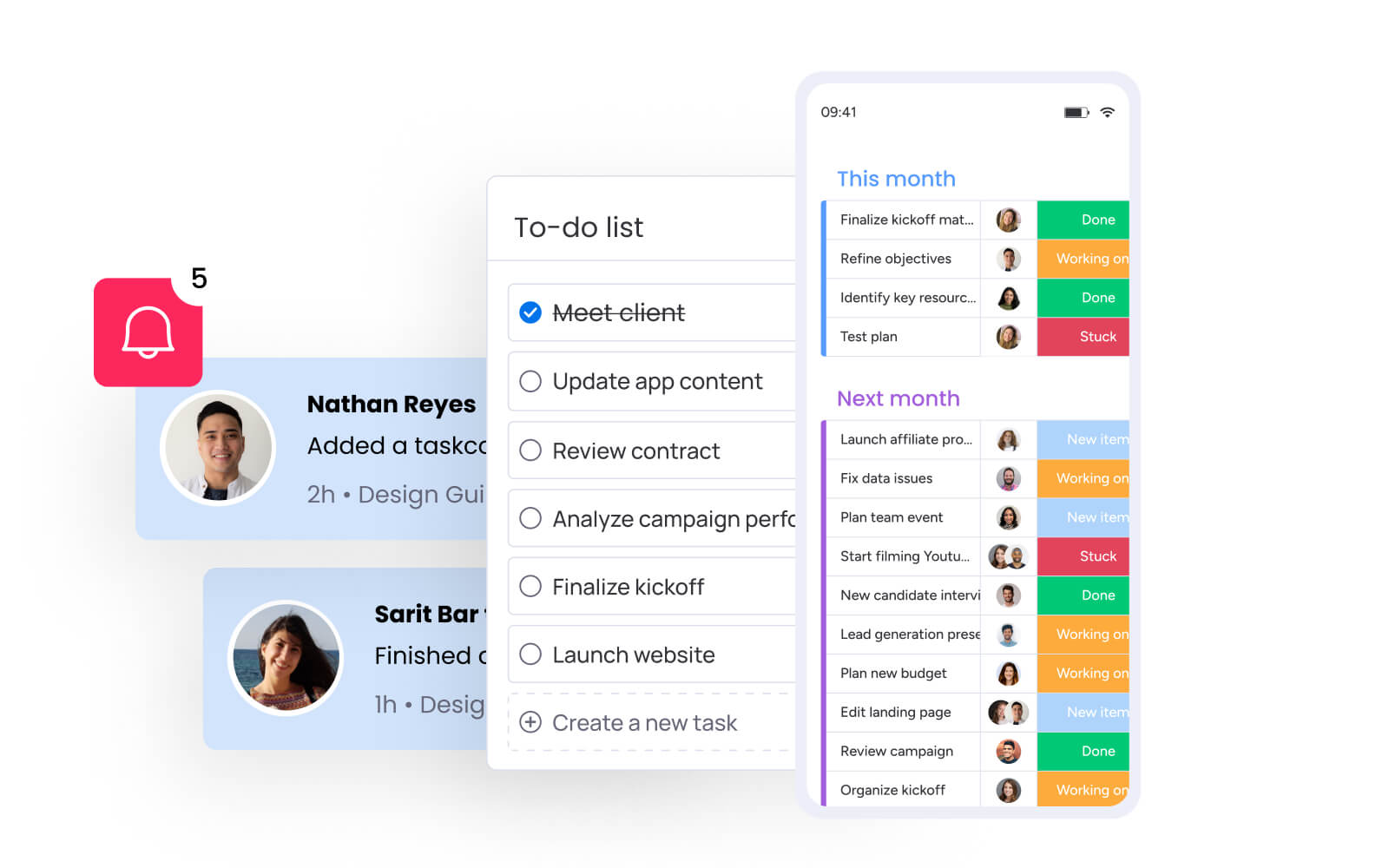
Success builds momentum. Track quantifiable improvements — such as time saved on handoffs — and share these stories. When teams see proof of value, skepticism turns into curiosity. Prioritizing the human element ensures adoption feels natural rather than forced, driving immediate value and long-term maturity.
Why monday work management excels at cross-departmental workflows
Silos crumble when teams have a shared digital environment. Whether marketing needs product input or onboarding involves IT, HR, and finance, monday work management streamlines these complex interactions. It connects the business while respecting the unique needs of each team.
This approach creates a unified workspace where collaboration happens without sacrificing preferred workflows.
- A single source of truth: Link marketing campaigns, sales enablement, and product development on one board for total visibility.
- Customized views for every team: Marketing can use a Kanban board while operations relies on a Gantt chart — all fed by the same data.
- End-to-end process ownership: Orchestrate processes from procurement to logistics with automations that keep work moving.
Ready to shift from reactive problem-solving to proactive optimization? Infuse cross-functional processes with practical AI using monday work management. Teams can automate handoffs, summarize documents, and monitor progress across departments. With 200+ native integrations and a robust API, data flows seamlessly between all your specialized platforms.
Orchestrate a brighter future of work
Ditching your patchwork of tools for a single platform isn’t just a tech upgrade — it’s a complete rethink of how work happens. When everyone can see the same information and work moves automatically between teams, those old departmental walls start to crumble. That’s when you start outpacing competitors.
Whether automating handoffs, securing data, or leveraging AI, the right platform empowers teams to execute with confidence. It transforms the flow of work, ensuring every initiative aligns with broader goals.
Focus on finding a solution that balances enterprise power with the flexibility your teams need. When adoption is high and friction is low, your organization gains the agility to adapt, scale, and deliver results faster.
Try monday work managementFAQs
What is the difference between workflow platforms and project management software?
Workflow platforms connect and automate processes across departments, whereas project management software typically focuses on managing tasks and deadlines within a single project or team.
How much do workflow platforms typically cost?
Costs vary based on user count, features, and support. Enterprise-grade platforms are priced to reflect their value, including advanced security, scalability, and administration.
Can workflow platforms integrate with existing business systems?
Yes, leading platforms offer extensive integration capabilities via native connections and APIs, allowing you to link critical software like CRMs and financial systems into a unified whole.
What are the most important features for cross-departmental workflows?
Key features include customizable workflows, powerful automation, and comprehensive reporting dashboards. These provide visibility while ensuring seamless work flow between teams.
How long does it take to implement a workflow platform?
Timelines range from a few months to over a year, depending on complexity and scale. Intuitive platforms are designed to accelerate this process significantly.
Do workflow platforms require technical expertise to manage?
No, many modern platforms feature no-code interfaces, empowering business teams to manage their own workflows and reducing dependency on IT.
What makes a workflow platform truly enterprise-grade?
An enterprise-grade platform offers robust security, scalable architecture, and the ability to connect complex processes into a single source of truth, acting as a comprehensive business operating system.
